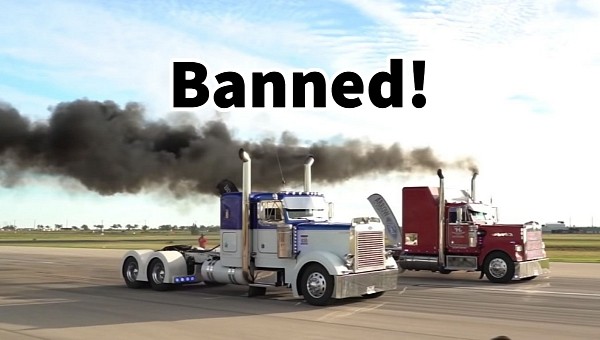California has always been at the forefront of emission regulations and is now moving to ban diesel trucks beginning in 2045. Despite the protests initiated by the trucking industry, EPA is expected to give California a waiver to move forward with the proposed legislation.
California has some of the toughest emissions regulations in the world, which explains why EV makers sell most of their U.S. cars in the Golden State. California has recently announced the banning of ICE light vehicles starting in 2035 and is moving with similar restrictions on heavy diesel trucks. The implications are far-reaching, considering that 14 states follow California’s Air Resource Board (CARB) standards. A ban on diesel trucks would be a devastating blow to the trucking industry, so a backlash is expected.
Curbing heavy-truck emissions is a necessary measure. The trucking industry is responsible for a third of California’s nitrogen oxide. It is also accountable for more than a quarter of the fine particle pollution. Both pollutants are linked to asthma, other respiratory illnesses, and premature death. Still, California needs the EPA to issue a waiver to implement its plans. According to sources cited by the Washington Post, the Biden administration will give the go-ahead in the following days.
The new legislation includes stricter pollution limits for heavy-duty vehicles such as delivery vans, garbage trucks, and 18-wheelers. The new limitations apply to vehicles starting with the 2024 model year. That's three years earlier than similar federal regulations, which begin with the 2027 model year.
Also, starting next year, truck makers will have to sell increasing percentages of zero-emissions trucks, buses, and vans every year. By 2045, all trucks should be battery-powered or running on hydrogen. Finally, a third part of the legislation mandates that manufacturers make sure their emission control devices work over the lifetime of the vehicles. This can be done by extending the warranty periods for this equipment.
The new trucking legislation is significantly slower than the light-duty regulations. In the latter case, carmakers would be banned from selling ICE vehicles in California starting in 2035. The gap reflects how much behind the trucking industry is. More than 135 electric heavy-truck and bus models are available in the U.S. Still, major truck manufacturers, such as Volvo and Daimler Trucks, indicated that they need more than a decade to put their clean-truck programs in motion.
The federal government is between a rock and a hard place, with environmentalists criticizing that EPA truck pollution rules are too soft. At the same time, the trucking industry has warned that the tougher rules would increase the cost of trucks, delaying new purchases and leaving older, dirtier vehicles on the roads for longer periods.
It seems that EPA has chosen the middle ground, rolling out softer regulations nationwide while letting California and the states that follow it set tougher rules.
Curbing heavy-truck emissions is a necessary measure. The trucking industry is responsible for a third of California’s nitrogen oxide. It is also accountable for more than a quarter of the fine particle pollution. Both pollutants are linked to asthma, other respiratory illnesses, and premature death. Still, California needs the EPA to issue a waiver to implement its plans. According to sources cited by the Washington Post, the Biden administration will give the go-ahead in the following days.
The new legislation includes stricter pollution limits for heavy-duty vehicles such as delivery vans, garbage trucks, and 18-wheelers. The new limitations apply to vehicles starting with the 2024 model year. That's three years earlier than similar federal regulations, which begin with the 2027 model year.
Also, starting next year, truck makers will have to sell increasing percentages of zero-emissions trucks, buses, and vans every year. By 2045, all trucks should be battery-powered or running on hydrogen. Finally, a third part of the legislation mandates that manufacturers make sure their emission control devices work over the lifetime of the vehicles. This can be done by extending the warranty periods for this equipment.
The new trucking legislation is significantly slower than the light-duty regulations. In the latter case, carmakers would be banned from selling ICE vehicles in California starting in 2035. The gap reflects how much behind the trucking industry is. More than 135 electric heavy-truck and bus models are available in the U.S. Still, major truck manufacturers, such as Volvo and Daimler Trucks, indicated that they need more than a decade to put their clean-truck programs in motion.
The federal government is between a rock and a hard place, with environmentalists criticizing that EPA truck pollution rules are too soft. At the same time, the trucking industry has warned that the tougher rules would increase the cost of trucks, delaying new purchases and leaving older, dirtier vehicles on the roads for longer periods.
It seems that EPA has chosen the middle ground, rolling out softer regulations nationwide while letting California and the states that follow it set tougher rules.






